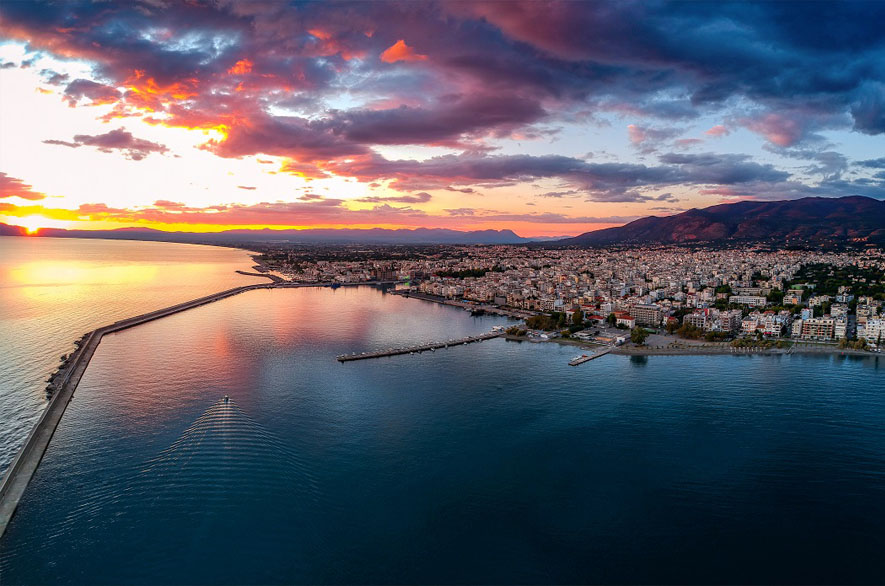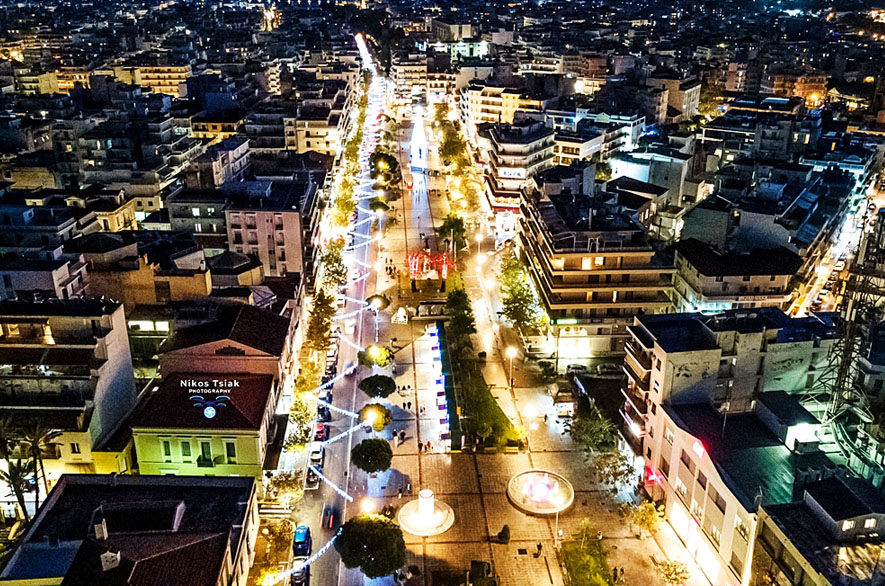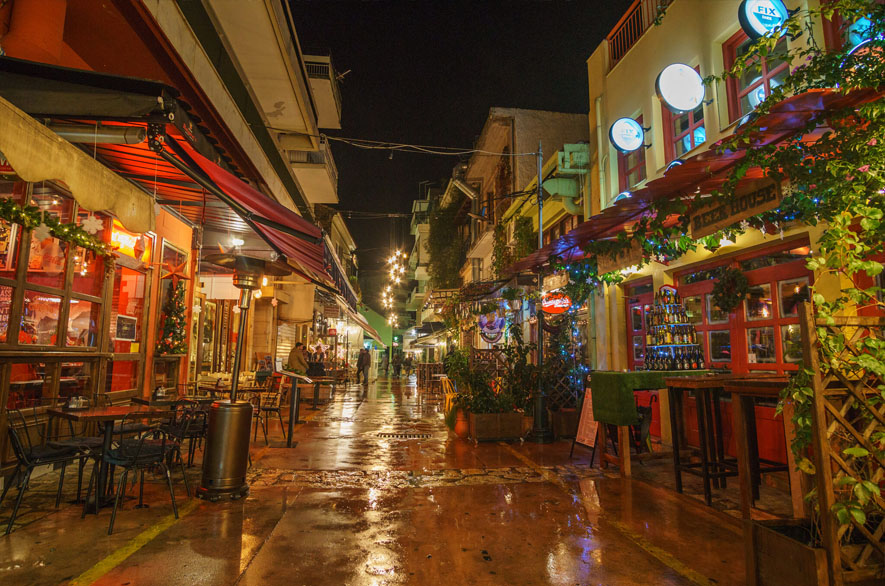Restaurant & Bar
tor's societies and spirits with our own, communicating
enthusiasm and liberality in the food we share. Official
Chef and Owner Philippe Massoud superbly creates a
blend of Lebanese, Levantine, Mediterranean.
Welcome to Kalamata, the queen of Peloponnese. A breathing, hospitable city that embraces the visitor and seduces him with its history and natural beauty.
The history of Kalamata begins with Homer, who mentions Fares, an ancient city built where the Frankish castle of the city is located today. Specifically, in rhapsody c of the Odyssey, Homer mentions that Telemachus spends the night in Fira where he seeks information about the fate of Odysseus. Επίσης, στη ραψωδία Ι της Ιλιάδας, οι Φηραί ήταν μία από τις επτά πόλεις που πρόσφερε ο Αγαμέμνονας στον Αχιλλέα για να επιστρέψει στη μάχη.
The most important event in the city’s long running history is its liberation from the Turks on March 23, 1821, a milestone date for the liberating struggle of the whole nation. On that day, Kolokotronis, Nikitaras, Petrobeis Mavromichalis, Papaflessas and other chiefs, entered the city as liberators and participated in the solemn doxology that took place in the Holy Temple of the Holy Apostles (small Byzantine church of the 12th Middle Ages which survives to this very day and is a powerful symbol for the city).
Kalamata is the second most populous city in the Peloponnese after Patras. It is an important urban, financial and commercial center of the region, as well as an administrative center of the Prefecture of Messinia. The economy of the region is based on agricultural production, with the most famous being the production of olive oil and olives which occupy the first places in the world in terms of quality. The area also produces figs, raisins and other products such as fruits and vegetables.
In winter, the city’s nightlife mostly lies in the historic center, while in summer it lies by the sea and its endless sandy beaches.
During the last few years, the Kalamata Carnival takes place in the city and along with it, a variety of carnival events. On the last Sunday of the carnival, a parade of carnival chariots takes place.
Additionally, during every July, the highly artistic and prestigious international dance festival takes place both in the City Hall and in other parts of the city, hosting performances and dancers from around the world. Many classes from the University of Peloponnese exist in Kalamata, with the university having undergone through a considerably large expansion and upgrade. The city has one of the largest bike lanes in the country, complete with modern sports facilities and an excellent road grid that connects it with the rest of Greece and last but not least, an international airport.
Kalamata is a city that will love you and you will certainly love it back. It will definitely earn a place in your heart and will make you want to visit it time and time again.
Welcome to Kalamata, the queen of Peloponnese. A breathing, hospitable city that embraces the visitor and seduces him with its history and natural beauty.
The history of Kalamata begins with Homer, who mentions Fares, an ancient city built where the Frankish castle of the city is located today. Specifically, in rhapsody c of the Odyssey, Homer mentions that Telemachus spends the night in Fira where he seeks information about the fate of Odysseus. Also, in Rhapsody I of the Iliad, Firai was one of the seven cities that Agamemnon offered to Achilles to return to battle.
The most important event in the city’s long running history is its liberation from the Turks on March 23, 1821, a milestone date for the liberating struggle of the whole nation. On that day, Kolokotronis, Nikitaras, Petrobeis Mavromichalis, Papaflessas and other chiefs, entered the city as liberators and participated in the solemn doxology that took place in the Holy Temple of the Holy Apostles (small Byzantine church of the 12th Middle Ages which survives to this very day and is a powerful symbol for the city).
Kalamata is the second most populous city in the Peloponnese after Patras. It is an important urban, financial and commercial center of the region, as well as an administrative center of the Prefecture of Messinia. The economy of the region is based on agricultural production, with the most famous being the production of olive oil and olives which occupy the first places in the world in terms of quality. The area also produces figs, raisins and other products such as fruits and vegetables.
In winter, the city’s nightlife mostly lies in the historic center, while in summer it lies by the sea and its endless sandy beaches.
During the last few years, the Kalamata Carnival takes place in the city and along with it, a variety of carnival events. On the last Sunday of the carnival, a parade of carnival chariots takes place.
Additionally, during every July, the highly artistic and prestigious international dance festival takes place both in the City Hall and in other parts of the city, hosting performances and dancers from around the world. Many classes from the University of Peloponnese exist in Kalamata, with the university having undergone through a considerably large expansion and upgrade. The city has one of the largest bike lanes in the country, complete with modern sports facilities and an excellent road grid that connects it with the rest of Greece and last but not least, an international airport.
Kalamata is a city that will love you and you will certainly love it back. It will definitely earn a place in your heart and will make you want to visit it time and time again.





The Castle of Kalamata is a fortificated building located in the current city of Kalamata. It is located on a hill to the northwest of the city with the river Nedontas passing at its foothills. The castle inside, contained a fortified citadel with ruins of a temple having been found inside. In ancient times, on that hill, the mythological hero Faris had built the Acropolis of the ancient city of Farai. There lied the palace of the kings of the city which is mentioned among those cities who took part in the Trojan War. In the 6th century AD. a Christian church was built on the ancient ruins and then the Byzantines fortified the place again.
Today the castle of Kalamata is used for various theater performances, events, concerts and is a very interesting visiting option.
The Castle of Kalamata is a fortificated building located in the current city of Kalamata. It is located on a hill to the northwest of the city with the river Nedontas passing at its foothills. The castle inside, contained a fortified citadel with ruins of a temple having been found inside. In ancient times, on that hill, the mythological hero Faris had built the Acropolis of the ancient city of Farai. There lied the palace of the kings of the city which is mentioned among those cities who took part in the Trojan War. In the 6th century AD. a Christian church was built on the ancient ruins and then the Byzantines fortified the place again.
Today the castle of Kalamata is used for various theater performances, events, concerts and is a very interesting visiting option.
The Museum building is located at the heart of the historic center of Kalamata, where the Municipal Market of the city used to be. It used to be flooded daily by the noisy crowd of traders and customers.
After the catastrophic earthquake of 1986, the marketplace building was demolished due to the severe damage it had suffered. The new building that took the place of the old marketplace was granted by the Municipality of Kalamata to the Ministry of Culture in order to function as an Archaeological Museum.
Following the old geographical division of the prefecture into four provinces, Kalamata, Messina, Pylia and Trifylia, the exhibition is divided into four larger respective geographical units which include the most important archaeological sites and findings.
The Museum building is located at the heart of the historic center of Kalamata, where the Municipal Market of the city used to be. It used to be flooded daily by the noisy crowd of traders and customers.
After the catastrophic earthquake of 1986, the marketplace building was demolished due to the severe damage it had suffered. The new building that took the place of the old marketplace was granted by the Municipality of Kalamata to the Ministry of Culture in order to function as an Archaeological Museum.
Following the old geographical division of the prefecture into four provinces, Kalamata, Messina, Pylia and Trifylia, the exhibition is divided into four larger respective geographical units which include the most important archaeological sites and findings.
Since 2013, Kalamata, the capital of dance, has acquired its own Hall.
With one of the largest stages in Greece, an area of 1,500 square meters, 675 spectator seats and 15 special seats for the disabled, it is undoubtedly the largest cultural building in the Peloponnese. It features an additional rehearsal room area of 350 square meters, used for the preparation of dancers and for events happening simultaneously with the ones taking place at the main hall. It also has administration and library areas, a canteen and a foyer.
Since 2013, Kalamata, the capital of dance, has acquired its own Hall.
With one of the largest stages in Greece, an area of 1,500 square meters, 675 spectator seats and 15 special seats for the disabled, it is undoubtedly the largest cultural building in the Peloponnese. It features an additional rehearsal room area of 350 square meters, used for the preparation of dancers and for events happening simultaneously with the ones taking place at the main hall. It also has administration and library areas, a canteen and a foyer.
The Municipal Railway Park of Kalamata operates since 1986. The museum consists of a former train station and a park of 54 acres. The exhibits of the Museum include the station and its area, with a two-storey station building, four boarding platforms with an entrance kiosk, a water tower, a metal 28 m long footbridge along the axis of the station and objects and parts of the railway landscape (change keys, lamps, stalls). Seven locomotives and a diesel locomotive are on display, a manual crane from 1890, two Dresins (bicycle and manual), three A-position passenger cars, five A’-B ‘1885 cars and eight trucks of various types (1885-1947). There are also SPAP, ST and EIS vehicles which serve as a place for refreshments, libraries, auxiliary spaces, etc. After the earthquake of 1986, many wagons became shelters for the homeless.
The Municipal Railway Park of Kalamata operates since 1986. The museum consists of a former train station and a park of 54 acres. The exhibits of the Museum include the station and its area, with a two-storey station building, four boarding platforms with an entrance kiosk, a water tower, a metal 28 m long footbridge along the axis of the station and objects and parts of the railway landscape (change keys, lamps, stalls). Seven locomotives and a diesel locomotive are on display, a manual crane from 1890, two Dresins (bicycle and manual), three A-position passenger cars, five A’-B ‘1885 cars and eight trucks of various types (1885-1947). There are also SPAP, ST and EIS vehicles which serve as a place for refreshments, libraries, auxiliary spaces, etc. After the earthquake of 1986, many wagons became shelters for the homeless.
Spreading over a large area, 30 km from Kalamata, lies Ancient Messini, one of the most important and rare archaeological sites in Greece.
The sight of the temples, houses, walls and public building which are preserved in all their great height and glory to this very day will most definitely impress you.
Ancient Messini was built in 369 BC. by the Theban general Epameinondas. The layout followed the so-called hippodame system, where all the buildings have the same orientation and the space is divided into horizontal and vertical axes. The wall that surrounded Ancient Messina has a total length of 9 mm.
Spreading over a large area, 30 km from Kalamata, lies Ancient Messini, one of the most important and rare archaeological sites in Greece.
The sight of the temples, houses, walls and public building which are preserved in all their great height and glory to this very day will most definitely impress you.
Ancient Messini was built in 369 BC. by the Theban general Epameinondas. The layout followed the so-called hippodame system, where all the buildings have the same orientation and the space is divided into horizontal and vertical axes. The wall that surrounded Ancient Messina has a total length of 9 mm.
